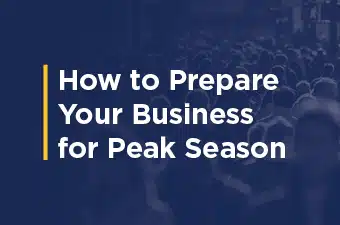If home parcel delivery is now a common challenge for retailers (which it is!), Peak Season is when it becomes even more challenging. Consumers’ experience of the season—and of the brands they’re relying on—can be permanently affected by the delivery experience.
For this reason, shippers are focusing on last mile delivery operations more than usual. But last mile performance is heavily influenced by first- and middle-mile factors. You can increase control by understanding how carriers get the goods into your possession, allowing you to plan and manage that portion of the process.
Container challenges
In one way, the container shipping disruption caused by the pandemic has eased. The queue of container vessels waiting to unload on the West coast has declined considerably. For example, imports were down 11% in September YoY and New York is now the busiest port in America.
Much of this reduced congestion is attributed to shippers rerouting their containers to Gulf and East coast ports. This was done not just to avoid the previous backlogs, but because Longshoremen’s and Railroad Workers’ unions contracts were expiring and strikes were possible.
In many cases, these new routes will be the norm moving forward. Depending on the final destination of your goods, this might mean longer overland transit times. And this, in turn, could add to your Cost of Goods. If that’s the case, sourcing your components, materials and/or finished products through closer ports would be worth investigating. You might also want to look into storage or warehousing solutions to avoid high container per diem charges.
Zones of influence
Unless your facilities are in the same shipping zone (geographic region) as the goods you source or you only deal in full truckloads, you will face zone charges. As LTL loads make their way across the country, they will stop in each zone to drop off some of the freight. The assumption is that your freight needs to be handled in the process, and that cost is baked into your rate.
One solution is setting up your own distribution centers in strategic locations. The goal is to shorten the trip from the point of origin to your operations. This offers the dual benefits of cutting down or eliminating zone charges and speeding delivery to your end-customers.
If that’s not practical, you should look into zone-skipping. This is like a full truckload solution that doesn’t stop between origin and destination. However, it carries LTL freight for multiple consignees bound for the same location. As you can imagine, this is not a solution for tertiary markets. But if you’re coordinating between major population centers, it can save both time and money.
The time savings come with the direct transit. And the cost savings come with the elimination of the zone charges, even allowing for some additional expense in getting your freight from the truck’s destination to your own.
One downside of zone-skipping is that you lose visibility into the merchandise in transit. This is a problem if customers routinely call your service representatives for updates. Another consideration is the coordination involved to arrange zone-skipping capacity. Even if you have a robust in-house logistics operation, tapping into a third-party logistics (3PL) provider with a wider view of the market allows you to sustain and scale this operation.
Multiplying the last miles
Even when you finally have your goods in your possession, what’s happening outside your supply chain can impact your last mile delivery. In this case, it’s mostly good news.
Because residential delivery is such a large—and growing—portion of retail, new resources are coming online at a brisk pace. Even as FedEx, UPS, USPS, Amazon Logistics and regional small parcel providers grow their volume, retailers such as Walmart (GoLocal), Target (Shipt), American Eagle Outfitters (Quiet Platforms) and lesser-known start-ups are entering the last mile delivery space.
The growing number of options will ensure capacity and lower costs as well as avoid delays. Here, too, working with a 3PL or a parcel consultancy can help you locate and manage the right resources for the customer experience and price points you want to offer.
This peak season promises to be a test of many new operations that are the legacy of the pandemic. This is also your chance to see how those adjustments affect the unique requirements of your business. Knowing how your goods are being handled before they get to you will give you greater insight into any differences you see in costs or service levels. And knowing that, you can begin to plan for them next season.
After years of feeling things were out of control, it’s time to take back that control… and then some. If you’d like some help doing that, we’d love to hear from you.










